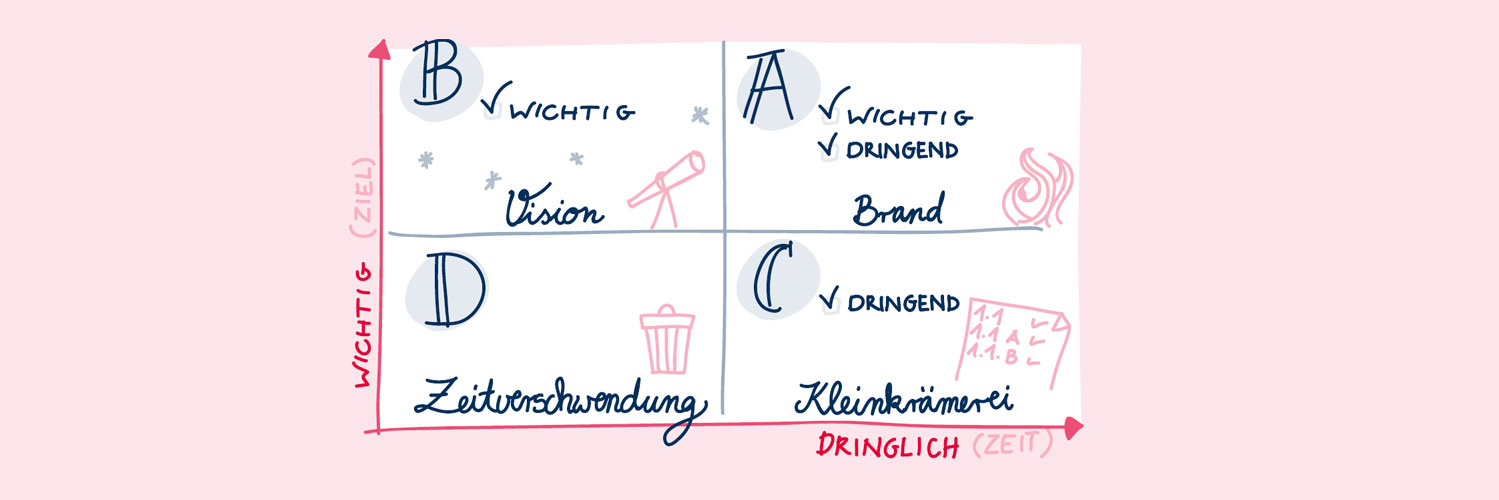Tasks are piling up on your desk, and you don’t know where to start? Utilize this smart method to effectively regain control of your to-dos according to your priorities.
The Eisenhower Matrix is a proven tool for effective time management and setting the right priorities. Based on the foundation of importance and urgency, it offers a clear structure for organizing tasks and optimizing the use of available time. Here, you will learn how exactly this method works and receive tips for its application.
What is the Eisenhower-Matrix?
The Eisenhower-Matrix, named after former US President Dwight D. Eisenhower, is a method for prioritizing tasks. It is based on dividing tasks into four quadrants according to their importance and urgency. But what exactly do “importance” and “urgency” mean?
Importance refers to the contribution of a task or activity to long-term goals and visions. It is about identifying which tasks contribute to long-term success, advance personal development, or achieve set goals. Important tasks are those that can have a direct impact on success and well-being. For example, they may include strategic projects, long-term goals, personal development, or strengthening relationships.
Urgency, on the other hand, describes the time frame within which a task needs to be completed. Urgent tasks require immediate attention and action, as they are often associated with deadlines or have immediate consequences if neglected. These may include short-term projects, urgent customer inquiries, immediate problem-solving, or important appointments.
How does the Eisenhower-Matrix work?
The Eisenhower-Matrix operates, as previously described, based on the distinction between importance and urgency. These two dimensions are crucial for categorizing tasks into the four quadrants:
Quadrant A encompasses tasks that are both important and urgent, requiring immediate attention. These might include urgent deadlines or acute problems.
Quadrant B includes important but not urgent tasks that support long-term goals and require strategic planning. Examples could be further education, long-term projects, or relationship-building.
Quadrant C covers tasks that are urgent but not important. These often involve interruptions, unnecessary meetings, or trivial requests that can be delegated or minimized. If delegation is not possible, such tasks should be addressed after Quadrant A tasks.
Quadrant D comprises tasks that are neither important nor urgent and should be avoided. These could include time-wasting activities, distractions, or unproductive pursuits. Such tasks can either be deleted or archived.
The clear structure of the Eisenhower Matrix enables effective task prioritization and optimal utilization of available time.
Priority Setting: The Significance of Importance and Urgency
Priority setting is a crucial aspect of effective time management and productivity. It involves consciously deciding which tasks or activities take precedence and which are less important. Deliberate priority setting using the Eisenhower Matrix allows limited resources, such as time, energy, and attention to be focused on tasks that offer the greatest benefit and highest value. This not only leads to a more efficient way of working but also fosters a sense of fulfillment and progress towards your goals and visions.
Tips for Using the Eisenhower-Matrix
• Focus on tasks in Quadrant B as they support long-term goals and enable long-term success. Additionally, it’s helpful to delegate tasks in Quadrant C to free up your own time for important activities.
• Regular Review: Take regular time to review your task list and enter them into the Eisenhower Matrix according to their importance and urgency. Weekly or daily reviews help maintain an overview and adjust priorities.
• Maintain Flexibility: Be flexible and adjust your priorities as needed. Sometimes circumstances change, and it’s important to be agile and focus on the most important tasks.
Feel free to check out our video featuring an example of application: In this video, time management expert Anjana Ahnfeldt explains how you can categorize individual tasks using the Eisenhower Matrix and find the right quadrant for each task.
The Eisenhower Matrix provides practical assistance in setting priorities and effectively managing your time. By focusing on the most important tasks and reducing unimportant activities, you can not only work more productively but also lead a balanced life based on your own goals and values. Use the Eisenhower Matrix to increase your productivity and successfully achieve your goals.
The greater your time management skills are, and the more effectively you handle your time, the lower your stress levels and the more satisfied you will be. If you want to strengthen your time management skills, then the certification for the persolog® Time Management Model is exactly right for you.



